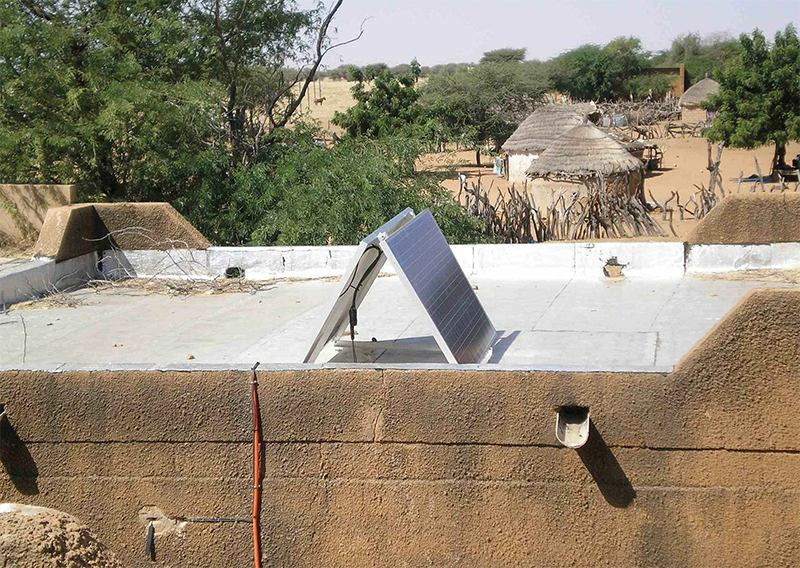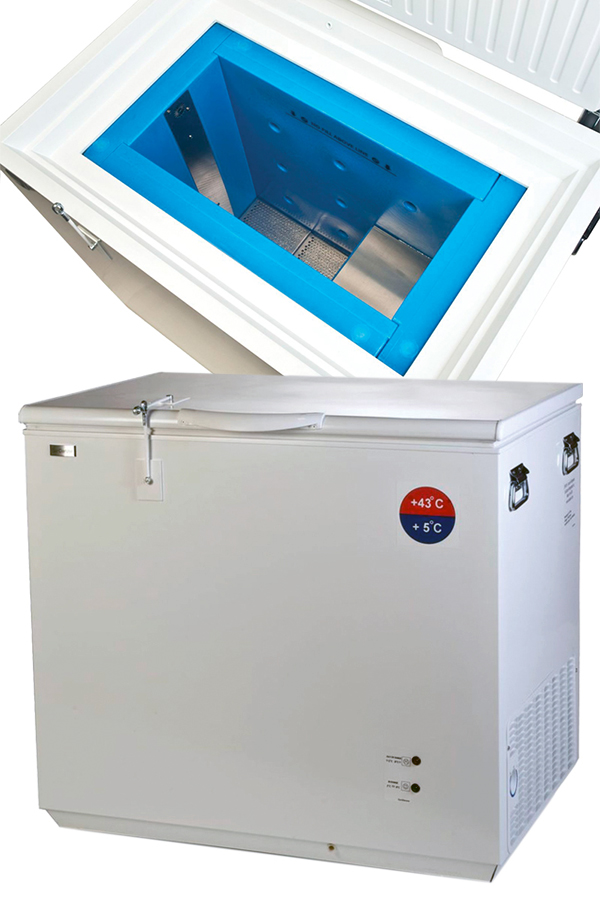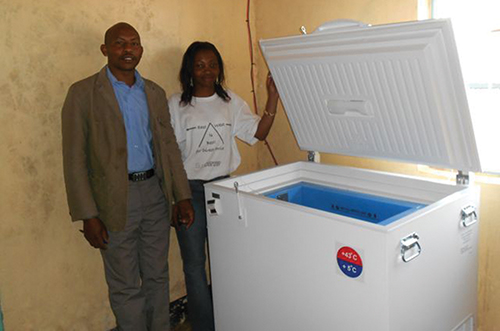
Solar Refrigerators Store Life-Saving Vaccines
NASA Technology
Over the years, NASA has advanced photovoltaic (PV) technology in order to advance many of its missions. This renewable source of energy is produced when certain “photoemissive” materials, such as silicon, eject electrons upon absorbing photons from sunlight. These free electrons can be captured, and the resulting current can be used as electricity. The Space Agency first used solar power in 1958 when Vanguard 1 was successfully launched into space.
Since then, NASA has harnessed the Sun’s energy to power many other satellites, probes, rovers, and even the International Space Station (ISS). The ISS’s iconic 115-foot solar array wings, each of which contains 32,800 solar cells that produce 32 kilowatts of electricity, were developed under the management of Glenn Research Center.
While photovoltaic technology has certainly benefitted space exploration, NASA has also helped transfer many of those technologies into a variety of commercial uses in telecommunications, water pumping systems, medical equipment, and lighting, just to name a few.
Technology Transfer
For his part, David Bergeron, who formerly headed the Advanced Refrigerator Technology Team at Johnson Space Center, sought to apply the innovations he helped develop—PV solar heat pumps for cooling lunar bases—here on Earth. After licensing the NASA technology, in 1999 he founded Solus Refrigeration Inc.—now called SunDanzer Refrigeration Inc.—and developed what became the company’s signature solar-powered refrigeration units, which have gone on to benefit many industries (Spinoff 2003).
One of the El Paso, Texas-based company’s models—a battery-free unit called the PV Direct-Drive model refrigerator—is now making another important contribution by ensuring that life-saving vaccines are available in rural communities all over the world.
SunDanzer’s PV Direct-Drive refrigerator was designed in the early 2000s for off-the-grid users who are located where the sun shines at least 5 hours per day. The unit connects directly to the solar panel, thereby eliminating the need for a charge controller or batteries, which can be tedious to replace and add extra cost over the lifetime of the unit. A key technology is the solar-powered vapor compression heat pump that circulates refrigerant throughout the interior and removes heat. In response to that process, a nontoxic, water-based phase change material freezes, creating an “ice pack” that enables temperature maintenance inside the enclosure.
With its low-maintenance dependability, in 2009 the refrigerator caught the attention of the Program for Appropriate Technology in Health, or PATH, a global health nonprofit organization that focuses on innovative technologies. PATH had established the Battery-Free Solar Refrigerator challenge, a contest where companies could apply for funding to qualify their refrigerators as suitable for vaccine storage with the World Health Organization (WHO). With encouragement from the organization, SunDanzer applied and won the funding.
In 2010, the company renewed its license with NASA for the battery-free technology, then started modifying the unit’s specifications to meet the WHO’s standards.
The task of making its refrigerator vaccine-friendly wasn’t easy, according to Jim Airola, SunDanzer’s director of business Development. The main challenge lies in maintaining a consistent degree of cold. “Vaccines thrive in a very specific temperature range, between around 35-46 °F,” he says, “and configuring our refrigerator to meet that level of precision turned out to be a complicated process.” But the company achieved that precision by, among other things, utilizing a fan to circulate the air more evenly and closing off areas near the top and bottom of the unit where the temperatures often fell out of the acceptable range.
All that work paid off when in 2011, following trial tests, the WHO prequalified the Solar Direct-Drive Vaccine Refrigerator, powered by NASA technology, as safe to use in hot zones around the world.
Benefits
According to Airola, SunDanzer’s vaccine refrigerator is an attractive option for clinics that operate in sunny, rural areas with little or inconsistent access to electricity.
First is the simplicity of design. “You don’t need any expertise to hook it up,” he says. “It’s just plug and play.” Its battery-free construction also means that fewer things can malfunction that would require an expert to fix. “With the conventional battery-powered units, there’s a lot of wiring and things that could go wrong if you don’t know what you’re doing. Our refrigerators require minimal maintenance and are intended to run for at least 15 years.”
And while these iceboxes work most efficiently with plenty of direct sunlight, the company’s proprietary phase change materials, which are adept at storing thermal energy, can sustain the unit’s internal temperature during bouts of heavy cloud cover. For instance, the refrigerator can withstand 3½ days during combination cloudy weather and outside temperatures of 109.4 °F. In addition, the corrosion-resistant steel exterior and the lockable top-opening door provide increased durability and security.
In the short period that SunDanzer’s vaccine refrigerators have been on the market, they have found homes in rural areas, such as in West African Senegal, where the company has installed 15 units. The United Nations Children’s Fund, which buys 40 percent of the global purchases of these refrigerators every year, is the company’s number one customer.
Through its work with PATH and the WHO, Airola says the company has learned a lot about how vaccines—and vaccine refrigerators—play an important role in staving off disease and maintaining public health, especially in developing countries. “We’re proud that our refrigerators play a role in helping people stay healthy,” he says. “It was well worth our efforts.”
SunDanzer™ is a trademark of SunDanzer Refrigeration Inc.

SunDanzer Refrigeration’s Solar Direct-Drive Vaccine Refrigerator doesn’t require batteries, which can be tedious to replace and add extra cost over the lifetime of the unit.

A SunDanzer Refrigeration unit is situated inside a Kenyan clinic.

A vaccine refrigerator’s solar panel is mounted to the roof of a rural African clinic. The United Nations Children’s Fund, which provides assistance to children in developing countries, is the company’s number one customer.













